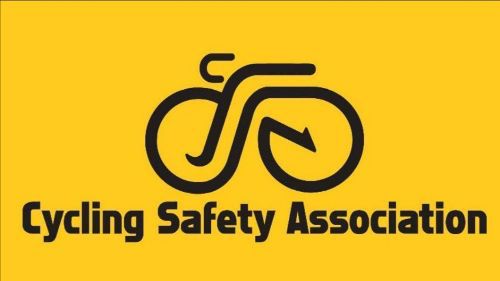How NOT to Get Hit by Cars
These Top 10 Tips Can Save Your Life
Collision Type #1: The Right Cross
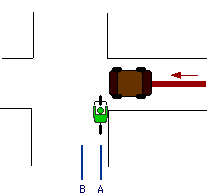
This is the most common way to get hit (or almost get hit). See Study. A car is pulling out of a side street, parking lot, or driveway on the right. Notice that there are actually two possible kinds of collisions here: Either you’re in front of the car and the car hits you, or the car pulls out in front of you and you slam into it.
How to avoid this collision:
(a) Make eye contact with the driver. This is the easiest and most effective way to avoid this accident. Of course, you have to make sure you have established eye contact. If you have, the motorist normally will not take his eyes off you until you have passed. After making eye contact, I sometimes point my finger forward so the driver clearly understands my intention of going through the intersection. If the motorist stops looking at you (or if it appears he is merely looking in your general direction), assume he has not seen you and begin to take evasive maneuvers as explained in the next paragraph.
(b) Move to the Center of the Lane. Look at the two blue lines “A” and “B” in the picture. You’re probably used to riding in “A,” very close to the curb, because you’re worried about being hit from behind. But take a look at the car. When that driver is looking down the road for traffic, he’s not looking in the bike lane or the area closest to the curb; he’s looking in the MIDDLE of the lane, for other cars. The farther left you are (such as in “B”), the more likely the driver will see you. There’s an added bonus here: if the motorist doesn’t see you and starts pulling out, you may be able to go even FARTHER left, or may be able to speed up and get out of the way before impact, or roll onto their hood as they slam on their brakes. In short, it gives you some options. If you stay all the way to the right and they pull out, your only “option” may be to run right into the driver’s side door.
(c) Honk, Yell, or Wave. If you are a commuter, I suggest you get a loud horn and use it whenever you see a car approaching (or waiting) ahead of you and to the right. If you’re on a road bike and you don’t want the extra weight of a horn, then yell “Hey!” You may feel awkward honking or yelling, but it’s better to be embarrassed than to get hit. I usually don’t resort to yelling until I have tried waiving to get the driver’s attention. “When in doubt, belt it out.” A friendly wave following your primal scream usually lightens up the situation.(d) Get a headlight. If you’re riding at night, you should absolutely use a front headlight. First, it’s impossible to establish eye contact with a motorist at night. Second, it’s required by law. Utah requires a white headlight visible from at least 500 feet ahead and a red taillight visible from 500 feet from behind. Even for daytime riding, a bright white light that has a flashing mode can make you more visible to motorists who might otherwise Right Cross you. Helmet- or forehead-mounted lights are the best because then you can look directly at the driver to make sure they see your light.
(e) Be ready to brake. In addition to the above, have your hands on your breaks, ready to pull. Drivers can be unpredictable; be ready for anything that comes at you.
Collision Type #2: The Door Prize
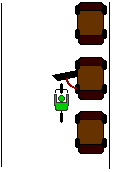
A driver opens his door right in front of you. You run right into it if you can’t stop in time. If you’re lucky, the driver will exit the car before you hit the door, so you’ll at least have the pleasure of smashing them, too, when you crash. AND, their soft flesh will cushion your impact. This kind of crash is more common than you might think, albeit almost entirely avoidable. How to avoid this collision: Ride to the left. Ride far enough to the left that you won’t run into any door that’s opened unexpectedly. You may be wary about riding so far into the lane that cars can’t pass you easily, but you’re more likely to get doored by a parked car if you ride too close to it than you are to get hit from behind by a car which can clearly see you. If you absolutely cannot move out into the lane, you’re better off stopping until you can. I also have the habit of looking into the car’s side-view mirror, which will often reveal if someone is in the car, in which case I take extra precaution.
Collision Type #3 The Crosswalk Slam
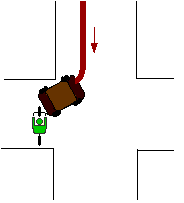
You’re riding on the sidewalk and cross the street at a crosswalk, and a car makes a right turn, right into you. Cars aren’t expecting bikes in the crosswalk, so you have to be very careful to avoid this one. This collision is extremely common. One study showed that sidewalk-riding was twice as dangerous as road riding, and another study said it’s even more dangerous than that. How to avoid this collision: Don’t ride on the sidewalk, especially against traffic. Crossing between sidewalks can be a fairly dangerous maneuver. If you do it on the left-hand side of the street, you risk getting slammed as per the diagram. If you do it on the right-hand side of the street, you risk getting slammed by a car behind you that’s turning right, especially in dedicated right turn lanes. You also risk getting hit by cars pulling out of parking lots or driveways. These kinds of accidents are hard to avoid, which should be reason enough not to ride on the sidewalk in the first place. Although riding on the sidewalk is allowed in Utah, if you are riding more than 5 mph, it’s just not safe. Young children riding on the sidewalk should dismount their bikes and walk them across streets using the same precautions any pedestrian should use.
Collision Type #4: The Wrong-Way Wreck
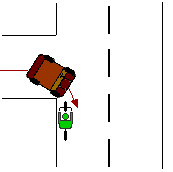
You’re riding the wrong way (against traffic, on the left-hand side of the street). A car makes a right turn from a side street, driveway, or parking lot, right into you. They didn’t see you because they were looking for traffic only on their left, not on their right. They had no reason to expect that someone would be coming at them at any considerable speed from the wrong direction. You can also be hit by a car traveling your same direction that is turning left. The driver is going to be looking for oncoming traffic, not traffic approaching from behind. Even worse, you could be hit by a car in a head-on collision. Traveling in opposition directions decreases both the driver’s and your reaction times, thereby increasing the chance of a collision. And if there is a collision, it’s going to be a much more forceful impact due to the combined velocities of two objects moving in opposite, as opposed to the same, direction.) How to avoid this collision: Don’t ride against traffic. It’s simple: ride with traffic, in the same direction. This applies even if there is a bike lane on the left side of the street, and even if local city ordinance allows bicycles to travel either direction in the bike lane. Unless the bike lane is separated from the road and sufficiently wide to accommodate two-way bicycle traffic, never ride against traffic. Riding against traffic may seem like a good idea (like joggers do) because you can see the cars that are passing you, but it’s not. Here’s why:
-
Cars that pull out of driveways, parking lots, and cross streets (ahead of you and to the left), and that are making a right onto your street, aren’t expecting traffic to be coming at them from the wrong way. Unlike joggers, you travel fast and will intersect with the car before the driver has the opportunity to see and react to your presence. You can plan on one of two things if you do this: (1) plowing into the side of the car, or (2) having the car plow into the side of you.
-
How the heck are you going to make a right turn?
-
Cars will approach you at a much higher relative speed. If you’re going 15 mph, then a car passing you from behind doing 35 approaches you at a speed of only 20 (35-15). But if you’re on the wrong side of the road, then the car approaches you at 50 (35+15), which is more than twice as fast! Because they’re approaching you faster, both you and the driver have a lot less time to react. And if a collision does occur, it’s going to be ten times worse.
-
Riding the wrong way is illegal and you can get ticketed for it. It also can submarine any hope you have of being compensated by the motorist who hit you.
One study showed that riding the wrong way was three times as dangerous as riding the right way, and for kids, the risk is seven times greater.
Collision Type #5: Red Light of Death
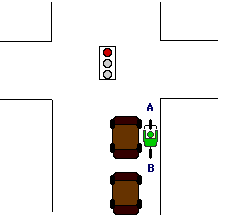 You stop to the right of a car that’s already waiting at a red light or stop sign. They can’t see you. When the light turns green, you move forward, and then they turn right, right into you. Even small cars can “do you in” in this way, but this scenario is especially dangerous when it’s a bus or a semi that you’re stopping next to. How to avoid this collision: Don’t stop in the blind spot. Simply stop BEHIND a car, instead of to the right of it, as per the diagram below. This makes you very visible to traffic on all sides. It’s impossible for the car behind you to avoid seeing you when you’re right in front of it. Another option is to stop at either point A in the diagram above (where the first driver can see you), or at point B, behind the first car so it can’t turn into you, and far enough ahead of the second car so that the second driver can see you clearly. It does no good to avoid stopping to the right of the first car if you’re going to make the mistake of stopping to the right of the second car. EITHER car can do you in. If you chose spot A, then ride quickly to cross the street as soon as the light turns green. Don’t look at the motorist to see if they want to go ahead and turn. If you’re in spot A and they want to turn, then you’re in their way. Why did you take spot A if you weren’t eager to cross the street when you could? When the light turns green, just go, and go quickly. (But make sure cars aren’t running the red light on the cross street, of course.) If you chose spot B, then when the light turns green, DON’T pass the car in front of you — stay behind it, because it might turn right at any second. If it doesn’t make a right turn right away, it may turn right into a driveway or parking lot unexpectedly at any point. Don’t count on drivers to signal! They don’t. Assume that a car can turn right at any time. (NEVER pass a car on the right!) But try to stay ahead of the car behind you until you’re through the intersection because otherwise, they might try to cut you off as they turn right. While I’m not advocating running red lights, notice it is, in fact, safer to run the red light if there’s no cross traffic, than it is to wait legally at the red light directly to the right of a car, only to have it make a right turn right into you when the light turns green. The moral here is not that you should break the law, but that you can easily get hurt even if you follow the law.
You stop to the right of a car that’s already waiting at a red light or stop sign. They can’t see you. When the light turns green, you move forward, and then they turn right, right into you. Even small cars can “do you in” in this way, but this scenario is especially dangerous when it’s a bus or a semi that you’re stopping next to. How to avoid this collision: Don’t stop in the blind spot. Simply stop BEHIND a car, instead of to the right of it, as per the diagram below. This makes you very visible to traffic on all sides. It’s impossible for the car behind you to avoid seeing you when you’re right in front of it. Another option is to stop at either point A in the diagram above (where the first driver can see you), or at point B, behind the first car so it can’t turn into you, and far enough ahead of the second car so that the second driver can see you clearly. It does no good to avoid stopping to the right of the first car if you’re going to make the mistake of stopping to the right of the second car. EITHER car can do you in. If you chose spot A, then ride quickly to cross the street as soon as the light turns green. Don’t look at the motorist to see if they want to go ahead and turn. If you’re in spot A and they want to turn, then you’re in their way. Why did you take spot A if you weren’t eager to cross the street when you could? When the light turns green, just go, and go quickly. (But make sure cars aren’t running the red light on the cross street, of course.) If you chose spot B, then when the light turns green, DON’T pass the car in front of you — stay behind it, because it might turn right at any second. If it doesn’t make a right turn right away, it may turn right into a driveway or parking lot unexpectedly at any point. Don’t count on drivers to signal! They don’t. Assume that a car can turn right at any time. (NEVER pass a car on the right!) But try to stay ahead of the car behind you until you’re through the intersection because otherwise, they might try to cut you off as they turn right. While I’m not advocating running red lights, notice it is, in fact, safer to run the red light if there’s no cross traffic, than it is to wait legally at the red light directly to the right of a car, only to have it make a right turn right into you when the light turns green. The moral here is not that you should break the law, but that you can easily get hurt even if you follow the law.
Collision Type #6: The Right Hook

A car passes you and then tries to make a right turn directly in front of you, or right into you. They think you’re not going very fast just because you’re on a bicycle, so it never occurs to them that they can’t pass you in time. Even if you have to slam on your brakes to avoid hitting them, they often won’t feel they’ve done anything wrong. This kind of collision is very hard to avoid because you typically don’t see it until the last second, and because there’s nowhere for you to go when it happens. How to avoid this collision: (a) Make sure you are not in a dedicated turning lane. If there is a dedicated turning lane, be sure to stay in the lane for thru traffic. Never drift into a dedicated turning lane (right or left) unless you are actually turning. (b) Don’t ride on the sidewalk. When you come off the sidewalk to cross the street you’re invisible to motorists. You’re just begging to be hit if you do this. (c) Ride to the left. Taking up the whole lane makes it harder for drivers to pass you to cut you off or turn into you. Don’t feel bad about taking the lane: if motorists didn’t threaten your life by turning in front of or into you or passing you too closely, then you wouldn’t have to. Some cyclists take the lane when approaching an intersection and then move to the right again once they are clear. I do this when necessary, but I also often just keep my eye on any car that comes up behind me to make sure I stay in a safe position. Obviously, if the lane you’re in isn’t wide enough for cars to pass you safely, then you should be taking the whole lane anyway. Lane position is discussed in more detail below. (d) Glance in your mirror or look over your shoulder before approaching an intersection. Be sure to look in your mirror or look over your should well before you get to the intersection. When you’re actually going through an intersection, you’ll need to be paying very close attention to what’s in front of you.
Collision Type #7: The Right Hook: Part 2

You’re passing a slow-moving car (or even another bike) on the right, when it unexpectedly makes a right turn right into you, trying to get to a parking lot, driveway or side street. How to avoid this collision: Don’t pass on the right. This collision is very easy to avoid. Just don’t pass any vehicle on the right. If a car ahead of you is going only 10 mph, then you slow down, too, behind it. It will eventually start moving faster. If it doesn’t, pass on the left when it’s safe to do so. When passing cyclists on the left, announce “on your left” before you start passing, so they don’t suddenly move left into you. (Of course, they’re much less likely to suddenly move left without looking, where they could be hit by traffic, then to suddenly move right, into a destination.) If they’re riding too far to the left for you to pass safely on the left, then announce “on your right” before passing on the right. If several cars are stopped at a light, then you can try passing on the right cautiously. Remember that someone can fling open the passenger door unexpectedly as they exit the car. Also remember that if you pass on the right and traffic starts moving again unexpectedly, you may suffer from collision #5, the Red Light of Death. Note that when you’re tailing a slow-moving vehicle, ride behind it, not in its blind spot immediately to the right of it. Even if you’re not passing a car on the right, you could still run into it if it turns right while you’re right next to it. Give yourself enough room to brake if it turns.
Collision Type #8: The Left Cross
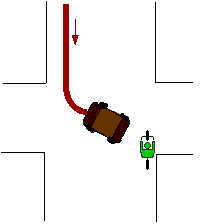
A car coming towards you makes a left turn right in front of you, or right into you. How to avoid this collision: (a) Don’t ride on the sidewalk. When you come off the sidewalk to cross the street, you’re invisible to turning motorists. (b) Get a headlight. If you’re riding at night, you should absolutely use a front headlight. As discussed above, it’s required by law. (c) Wear something bright, even during the day. It may seem silly, but bikes are small and not easy to see, even during the day. Yellow or orange reflective vests really make a big difference. Reflective leg bands are also easy and inexpensive. (d) Don’t pass on the right. Don’t overtake slow-moving vehicles on the right. Doing so makes you invisible to left-turning motorists at intersections. Passing on the right means that the vehicle you’re passing could also make a right turn right into you, too. (e) Slow down. If you can’t make eye contact with the driver (especially at night), slow down so much that you’re able to completely stop if you have to. Sure, it’s inconvenient, but it beats getting hit.
Collision Type #9: The Rear End
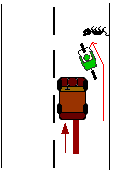
You innocently move a little to the left to go around a parked car or some other obstruction in the road, and you get nailed by a car coming up from behind. How to avoid this collision: (a) Never, ever move left without looking behind you first. Some motorists like to pass cyclists within mere inches (despite the “three feet” law), so moving even a tiny bit to the left unexpectedly could put you in the path of a car. Either buy a mirror, or practice holding a straight line while looking over your shoulder until you can do it perfectly. Most new cyclists tend to move left when they look behind them, which of course can be disastrous. (b) Don’t swerve in and out of the parking lane if it contains any parked cars. You might be tempted to ride in the parking lane where there are no parked cars, dipping back into the traffic lane when you encounter a parked car. This puts you at risk for getting nailed from behind. Instead, ride a steady, straight line in the traffic lane.
Collision Type #10: The Rear End Part 2
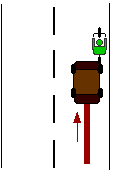
A car runs into you from behind. This is what many cyclists fear the most, but it’s actually not very common, comprising only 3.8% of collisions. (Source) However, it’s one of the hardest collisions to avoid, since you’re not usually looking behind you. The risk is likely greater at night, and on rides outside the city where traffic is faster and lighting is worse. How to avoid this collision: (a) Get a rear light. If you’re riding at night, you absolutely should use a flashing red rear light. It’s not only safe, it is the law. Bike shops have red rear blinkies for $15 or less. I can’t stress this item enough: If you ride at night, get a rear light! I often use one even in the day. (b) Wear a reflective vest or a safety triangle. High-quality reflective gear makes you a lot more visible even in the daytime, not just at night. (c) Choose wide streets. Ride on streets whose outside lane is so wide that it can easily fit a car and a bike side by side. (Or streets with a large shoulder.) That way a car may zoom by you and avoid hitting you, even if they didn’t see you! (d) Choose slow streets. The slower a car is going, the more time the driver has to see you. I navigate the city by going through neighborhoods whenever practicable. Learn how to do this. (e) Use back streets on weekends. This is especially important on Friday and Saturday nights because all the drunks are out driving around. If you do ride on a weekend night, make sure to take neighborhood streets rather than arterials. (f) Don’t hug the curb. This is counter-intuitive, but giving yourself a little space between yourself and the curb will make you much more visible to traffic. Also, when you hug the curb tightly, you’re more likely to suffer a right cross from motorists who can’t see you, not to mention encounter debris in the road.
More General Tips
Avoid busy streets.
One of the biggest mistakes that people make when they start biking is to take the exact same routes they used when they were driving. It’s usually better to take different streets with fewer and slower cars. Sure, cyclists have a right to the road, but that’s a small consolation when you’re dead. Consider how far you can take this strategy: If you learn your routes well, you’ll find that in many cities you can travel through neighborhoods to get to most places, only crossing the busiest streets rather than traveling on them.
Light up.
Too obvious? Well, if it’s so obvious, then why do most night-time cyclists ride without lights? Bike shops have rear red blinkies for $15 or less. Headlights are just as important as rear lights. And modern headlights use LED’s so the batteries last ten times longer than old-school headlights.
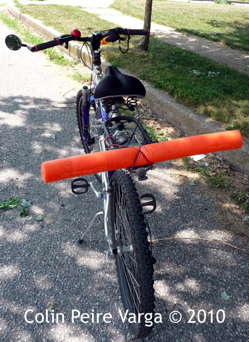 One cyclist tied this bright noodle to the back of his bike, exactly the width of his handlebars, to show drivers how much space he takes up on the road. |
Take the whole lane when appropriate.
It’s often safer to take the whole lane, or at least ride a little bit to the left, rather than hug the right curb. Here’s why:
- Cars at intersections ahead of you can see you better if you’re squarely in the road rather than on the extreme edge where you’re easily overlooked.
- Taking the lane prevents cars from passing you too closely on narrow roadways.
- Riding a bit to the left prevents you from being a victim of the door prize.
You might worry about slowing down the traffic behind you if you take the lane. But if you’re on the kind of street where you’ve got cars blocked up behind you or constantly changing lanes to get around you, you’re probably on the wrong street and should find a quieter neighborhood street.
Taking the lane works especially well in most traffic circles. The traffic generally moves slower so it’s easy to keep up, riding in the lane makes you more visible to motorists, and taking the lane prevents motorists from right hooking you as they exit the circle.
It’s perfectly legal for you to take the lane when appropriate. Texas State Law (and the laws of most other states) says you have to ride as far to the right as is “practicable”. Here are some things that make it impracticable to ride to the extreme right:
- You’re in a heavy traffic area with lots of side streets, parking lots, or driveways ahead and to your right. Cars turning left won’t see you because they’re looking for traffic in the middle of the road, not on the extreme edge of the road. Move left. See Collision diagram #1 above.
- Cars are passing you too closely. If the lane is too narrow for cars to pass you safely, then move left and take the whole lane. Getting buzzed by cars is dangerous.
- Cars are parked on the right-hand side of the road. If you ride too close to these you’re gonna get doored when someone gets out of their car. Move left.
There are risks to both riding to the extreme right as well as taking the lane. Whether you ride to the right or take the lane depends on the conditions of the roadway you’re on. On wide roadways with few intersections/driveways, right further right. On narrow roads with lots of intersections, ride farther to the left. It’s not always better to take the lane or to hug the curb; it depends on the roadway you’re on.
Signal your turns.
You’re less likely to get hit when your movement doesn’t take motorists by surprise. Let them know you’re about to turn or move left or right by signalling with your arm. Point your left arm out to move left, and point your right arm out to move right. (You might have learned an old way of signaling a right turn with your left arm, but drivers have no idea what that means, so it’s useless. Signal a right turn with your right arm.) Before signaling left, be sure to check your mirror or look behind you before signaling (since a car passing too closely can take your arm out).
Re-think music players and mobile phones.
It’s more important to hear what’s around you when you’re biking than when you’re driving. Whether you want to ride with headphones is your choice, but doing so does increase your risk. Similarly, texting or talking with a mobile phone raises the risk level. When you’re mixing with car traffic, the fewer distractions the better. Also, you’ll want both hands free in case you have to brake suddenly.
Ride as if you were invisible.
It’s often helpful to ride in such a way that motorists won’t hit you even if they don’t see you. You’re not trying to be invisible, you’re trying to make it irrelevant whether cars see you or not. If you ride in such a way that a car has to see you to take action to avoid hitting you (e.g., by their slowing down or changing lanes), then that means they will definitely hit you if they don’t see you. But if you stay out of their way, then you won’t get hit even if they didn’t notice you were there.
On very fast roads cars have less time to see you because they’re approaching so fast. Of course, you should avoid fast roads in the first place if at all possible, unless there’s plenty of room for a car and a bike side by side. And if there IS such room, then on fast roadways, you can practice invisibility by riding to the extreme right. If you’re far enough right that you’re not in the part of the lane the cars are in, then they’ll zoom by and won’t hit you, even if they never saw you.
Here’s another example: It’s a good idea to signal a left turn, but it’s a better idea to make your left turn at a time or place where there aren’t cars behind you that could hit you while you’re stopped and waiting to make that turn. You can hang out in the middle of the street, stopped, with your left arm out, waiting to make your turn, but you’re counting on cars behind you to see you and stop. If they don’t see you, you’re in trouble.
Naturally we don’t advocate running red lights, but if you’re the kind of person who does, then apply the invisibility principle when deciding on whether to run a particular light: Could any cross traffic possibly hit me if I were invisible? If yes, then absolutely don’t do it. Never make a car have to slow down to avoid hitting you (red light or not). Remember, the more you rely on cars to see you to avoid hitting you, the more chances they’ll have to actually do so.
Remember, you’re not trying to BE invisible, you’re just riding with the assumption that cars can’t see you. Of course, you certainly want them to see you, and you should help them with that. That’s why you’ll wave to motorists whom you think might be about to pull out in front of you, and why you’ll be lit up like a Christmas tree at night (front and rear lights).
Remember that in many cases you’ll need to take the lane, in which case you’re counting on motorists to see you.
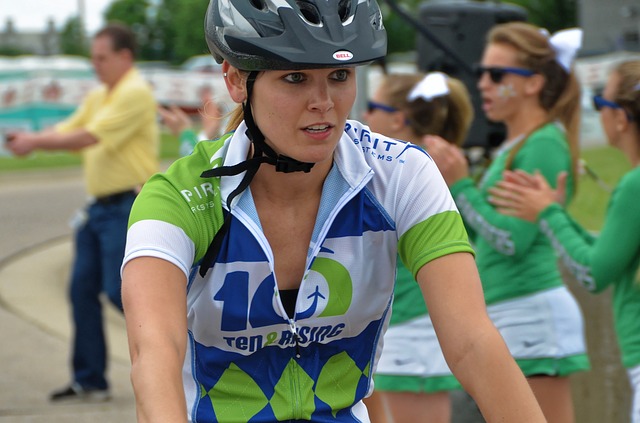
Credit: BicycleSafe.com
